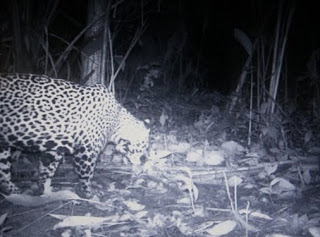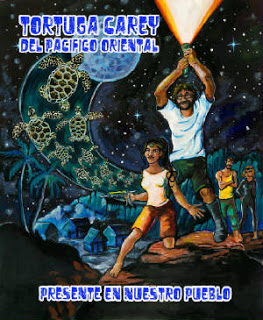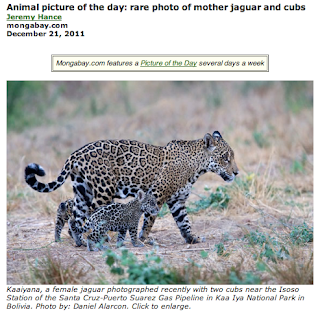The mysteriously rich diversity of life on the isle of Madagascar might have arrived there in part on “floating islands” carried by ocean currents, researchers now say.
Madagascar, the world’s fourth-largest island, is the sole home to a wide variety of animal species, most of which are thought to have reached Madagascar after plate tectonics separated it from Africa and other continents.
…
But not all scientists have been convinced by this theory.
“There has been a great debate about rafting over at least the past 50 years,” Samonds said. “While many authors have argued that dispersal events by terrestrial, land-dwelling animals across great distances of water are virtually impossible, others have argued that even unlikely events are certain to occur if the time elapsed is long enough, and that prevailing ocean currents could have aided these journeys.”
 Jaguars are among the most charismatic and important large carnivores in Latin America. However, they have lost much of their range to human activities like logging and ranching, which destroy their habitat and reduce their populations. Additionally, they are subject to hunting and persecution by people trying to protect their cattle and domestic animals.
Jaguars are among the most charismatic and important large carnivores in Latin America. However, they have lost much of their range to human activities like logging and ranching, which destroy their habitat and reduce their populations. Additionally, they are subject to hunting and persecution by people trying to protect their cattle and domestic animals.
- Where do populations of jaguars persist in southwestern Nicaragua?
- How do they manage to survive in a heavily populated landscape dominated by ranching?
- What role does western Nicaragua’s jaguar population play in the conservation of this species?
- How can we protect this vulnerable population of jaguars?
The Telegraph interviews the man behind the movie: ‘There were lots of times when I thought, “What have I done?”’ Mee says now. ‘But when the jaguar escaped it was the first time I realised there were lives at stake.’

Miguel Ordeñana, the wildlife biologist leading our jaguar conservation efforts, has begun blogging at Urban Carnivores, where he’ll be reporting on big cats in LA’s Griffith Park, and in the Paso del Istmo.
 Mongabay.com’s Picture of the Day is from Bolivia.
Mongabay.com’s Picture of the Day is from Bolivia.
This jaguar mother was photographed with her two cubs in the Kaa Iya National Park in Bolivia.
“Kaaiyana’s tolerance of observers is a testimony to the absence of hunters in this area, and her success as a mother means there is plenty of food for her and her cubs to eat,” said John Polisar, coordinator of Wildlife Conservation Society’s (WCS) Jaguar Conservation Program. WCS released the photos.
AKA why we love the Guardian’s GrrlScientist:
“Big cat” is not a precise biological term, it is just a verbal shorthand for distinguishing the larger members of the taxonomic family Felidae from smaller ones. Some people formally define “big cats” as the four Panthera species: the tiger, lion, jaguar, and leopard. But other people also include cheetahs, snow leopards, clouded leopards, and cougars under the “big cat” umbrella.
Big cat noises are really interesting. For example, only Panthera can roar. For this reason, they are often collectively known as “the roaring cats”. Roaring requires special morphology of the larynx and hyoid apparatus in the animal’s throat. Interestingly, despite having hyoid morphology similar to roaring cats, snow leopards cannot roar.
The Science Behind the Big Cat Sounds
Among the most striking characteristics of cats, the sounds they produce are very interesting: from deep growth to impressive thunderstorms, it can be very varied. A big cat roar is possible for special animals from the throat. It increases and increases the sound over long distances, causing lions to dominate their areas and tigers through dense forests. Beyond the roar, the variety of the wild cat sounds – which increases their behavior, mood, and social interaction, can also vary their methods of communication.
Researchers have long studied these sounds and how they play a role in survival. For example, Roars can prevent dominance and rivals, while the soft tone strengthens social bonds between mothers and cubs. By analyzing the full spectrum of wild cat sounds, scientists learn that they attain insights into adaptation that allow these animals to flourish in such separate habitats, from open savannas to high mountain ranges.
Read more at The Guardian. Or simply watch the video from Big Cat Rescue:
In Bolivia’s Madidi National Park:
Researchers from the Wildlife Conservation Society (WCS) set up the camera traps to try and identify jaguars based on the unique patterns of their spots. Once the images were collected, the team ran them through software originally designed to recognize tigers by their stripes.
The 19 jaguars found by the project represent a record number for a single camera-trap survey in the country.
Read more about it at National Geographic Daily News.
Smithsonian.com’s Science & Nature, reports on “a bold plan for wildlife corridors that connect populations from Mexico to Argentina could mean the big cat’s salvation.”
In antiquity, killing a jaguar was often part of a religious ceremony or a mark of status. But as ranches and settlements sprang up across Latin America, jaguars lost their religious significance. Demonized as dangerous predators, they were routinely shot. The fashion craze for fur after World War II added to the carnage; in 1969 alone, the United States imported nearly 10,000 jaguar pelts. Only a 1973 international ban stemmed the trade. Killing jaguars is now illegal throughout their range, but enforcement is minimal, and the cats have been wiped out in El Salvador and Uruguay. Meanwhile, over the past century people have razed or developed 39 percent of jaguars’ original habitat across Central and South America.
…
Panthera’s Jaguar Corridor Initiative aims to connect 90 distinct jaguar populations across the Americas. It stems from an unexpected discovery. For 60 years, biologists had thought there were eight distinct subspecies of jaguar, including the Peruvian jaguar, Central American jaguar and Goldman’s jaguar. But when the Laboratory of Genomic Diversity in Frederick, Maryland, part of the National Institutes of Health, analyzed jaguar DNA from blood and tissue samples collected throughout the Americas, researchers determined that no jaguar group had split off into a true subspecies. From Mexico’s deserts to the dry Pampas of northern Argentina, jaguars had been breeding with each other, wandering great distances to do so, even swimming across the Panama Canal. “The results were so shocking that we thought it was a mistake,” Rabinowitz says.
Panthera has identified 182 potential jaguar corridors covering nearly a million square miles, spanning 18 nations and two continents. So far, Mexico, Central America and Colombia have signed on to the initiative. Negotiating agreements with the rest of South America is next. Creating this jaguar genetic highway will be easier in some places than others. From the Amazon north, the continent is an emerald matrix of jaguar habitats that can be easily linked. But parts of Central America are utterly deforested. And a link in Colombia crosses one of Latin America’s most dangerous drug routes.
…
“My vision was to ranch by example,” Kaplan says, “to create ranches that are more productive and profitable and yet are truly jaguar-friendly.”
Our friends at the Wildlife Conservation Society have had a great deal of success identifying individual jaguars with camera traps in Bolivia’s Madidi National Park:
A record number of jaguars have been identified in one of the world’s most biologically diverse landscapes. Using technology first adapted to identify tigers by stripe patterns, researchers for the Wildlife Conservation Society have identified 19 individual jaguars by spot patterns in the rainforests of Bolivia, a record number for a single camera trap survey in the country.
“We’re excited about the prospect of using these images to find out more about this elusive cat and its ecological needs,” said WCS conservationist Robert Wallace. “The data gleaned from these images provide insights into the lives of individual jaguars and will help us generate a density estimate for the area.”
We’re so excited to follow in their footsteps with our own Jaguar Conservation Initiative.